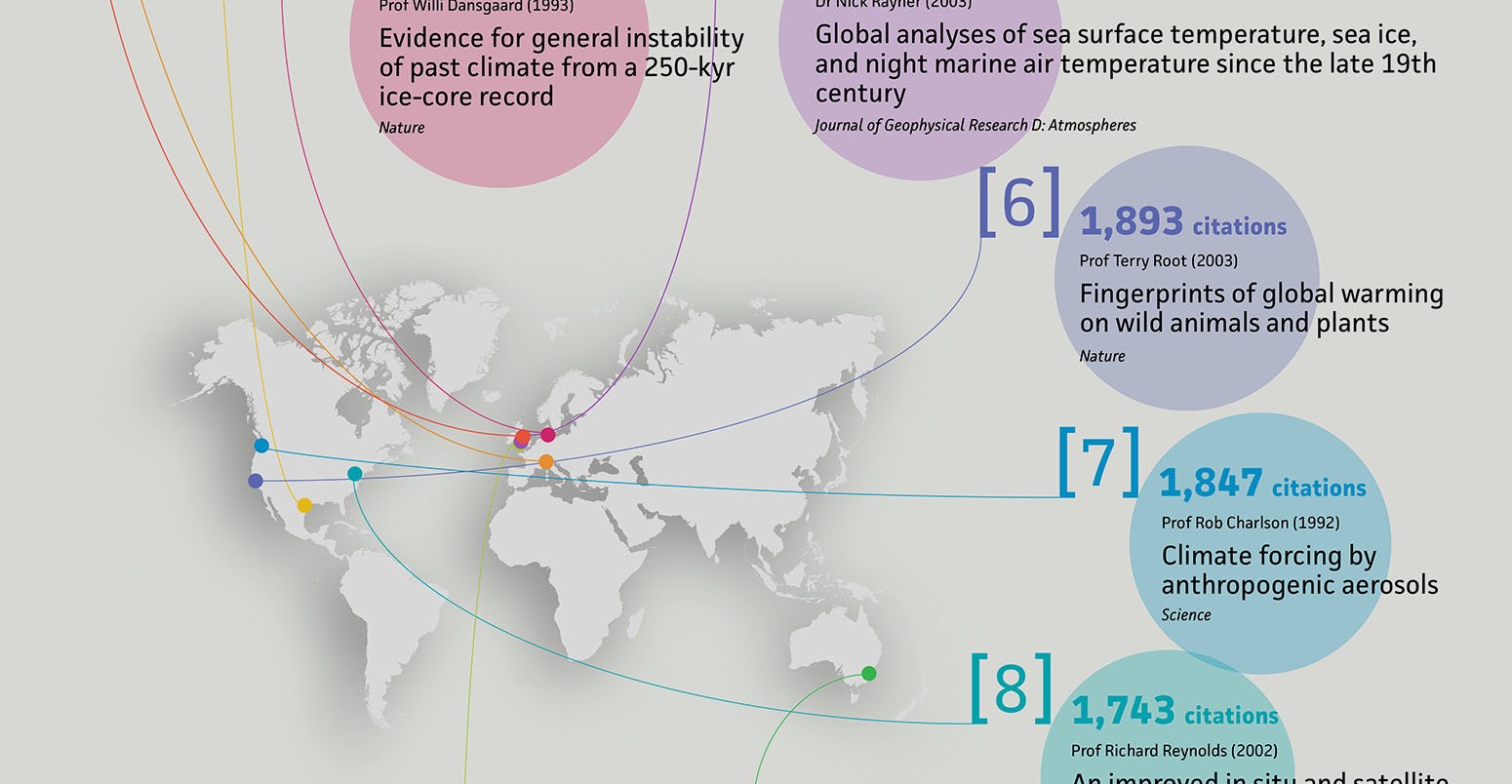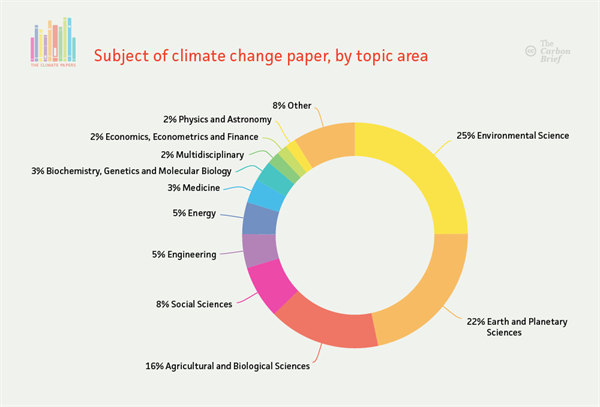
Analysis: The most ‘cited’ climate change papers
Robert McSweeney
07.08.15On Monday, we revealed the results of our survey of scientists in which we asked them to name the “most influential” climate change papers of all time.
The most popular nomination was a seminal paper by Syukuro Manabe and Richard T Wetherald published in the Journal of the Atmospheric Sciences in 1967.
Now, we turn from the subjective to the objective and look at which are the most “cited” climate change papers. Here, Carbon Brief analyses which papers have had the biggest impact in the academic world, and who wrote them.
Thousands of peer-reviewed academic papers are published about climate change every year. These articles form the bedrock of climate science, underpinning the assessment reports from the Intergovernmental Panel on Climate Change (IPCC).
With so many papers from so many journals, some inevitably sink without trace. But others become the centrepiece of their field or spark new areas of research.
Published papers
There are various databases to search through which list the thousands of academic papers published each year. Amidst options such as Google Scholar and Web of Science, we plumped for Scopus, the world’s largest abstract and citation database of peer-reviewed literature.
In Scopus, we searched for any academic paper with the phrase ‘climate change’ or ‘global warming’ in its title, abstract or keywords. We also tried using just ‘climate’ for the searches, but that produced a very broad range of articles. As we wanted to look at both the top papers and all papers far beyond the top 100, we wouldn’t have manually been able to filter out all the non-climate papers for the analysis. So we went with ‘climate change’ and ‘global warming’, though this does mean that some climate change papers without those terms in the title, abstract or keywords would miss out.
But in response to queries from some climate scientists, we’ve also, for comparison, included the top 10 ‘climate’ papers at the end of the article.
We then limited the search to give us only pure research articles, filtering out other publications such as book chapters, conference papers, review articles and editorials.
The search yields a total of almost 120,000 papers, as of the beginning of June this year. You can see below how the number of published papers about climate change took off during the 2000s.

Total number of climate change papers published, by year. Data from Scopus. Credit: Rosamund Pearce, Carbon Brief
As the chart below shows, most of the papers relate to environmental science (25% of papers), earth and planetary science (22%) and agricultural and biological sciences (16%). But the search also unearths papers from social science (8%), medicine (3%) and even dentistry (0%, or 4 papers).

Subject of climate change papers, by topic area. Data from Scopus. Credit: Rosamund Pearce, Carbon Brief
Most prolific
Across all 120,000 papers, the most prolific author is Dr Philippe Ciais from the Laboratoire des Sciences du Climat and de l’Environment in Paris. Ciais has 120 published articles on climate change, mostly about the global carbon cycle.
Coming in second is Prof Richard Tol, from the Department of Economics at the University of Sussex, with 113. And third place goes to Prof Josep Penuelas, director of the Global Ecology Unit at the Universitat Autònoma de Barcelona. You can see the rest of the top 10 in the graphic below.

Top 10 most prolific authors of climate change papers. Data from Scopus. Credit: Rosamund Pearce, Carbon Brief
But while the number of publications shows how prolific a researcher is, it doesn’t reveal how influential their work is. To do that we need to look at citations.
Citation, citation, citation
In an academic paper, scientists will refer to previous work by other scientists in their field. This may be to set the scene of their research or acknowledge a method or finding that someone else produced. In doing this they refer to, or ‘cite’, other academic papers.
Databases such as Scopus keep track of how many times each paper has been cited by others. We extracted the 100 most cited climate change papers.
The top paper, with 3,305 citations, is Nature paper, ” A globally coherent fingerprint of climate change impacts across natural systems“, by Prof Camille Parmesan, at the University of Texas and Plymouth University, and Prof Gary Yohe, from Wesleyan University.
Published in 2003, the paper assessed the global impact of climate change on more than 1,700 biological species, from birds and butterflies to trees and alpine herbs. Parmesan and Yohe found that 279 species are already being affected by climate change, and 74-91% of these changes agree with what is expected from projections.
This paper also featured in our analysis as one of the papers that IPCC authors considered the most influential.
In runners-up spot is an Ecological Modelling paper from 2000, ” Predictive habitat distribution models in ecology“, with 2,746 citations. The paper was written by Prof Antoine Guisan, now of the Université de Lausanne, and Dr Niklaus Zimmerman of the Swiss Federal Research Institute.
And coming in third is ” Extinction risk from climate change“, again published in Nature, with 2,562 citations. This 2004 paper has 19 authors, but the lead was Dr Chris Thomas from the University of Leeds.
Our infographic below shows the top 10 most cited papers on climate change.
Crossover
Apart from the Parmesan and Yohe article, just one of our top most influential papers according to IPCC authors makes the top 100 of most cited. This is the Journal of Climate paper “ Robust responses of the hydrological cycle to global warming“, by Prof Isaac Held and Prof Brian Soden, which comes in 34th.
So where are the climatic luminaries of Syukuro Manabe, Guy Callendar and Charles Keeling? Well, primarily, Scopus doesn’t yet have complete citations for papers published before 1996, so older papers might be underrepresented in the top 100 most cited.
But another reason could be that papers tend to have more citations in recent years because there are more papers on climate change being published, so more opportunities to be cited. This is reflected in the top 100, where most are from 2000 onwards, and none before 1988.
Likewise, very recent papers don’t appear in the top 100 because they haven’t been around long enough to accrue citations. The most recent paper in the top 100 was published in 2011.
Most appearances
So we’ve looked at which authors produce the most papers, but which have appeared most often in the top 100 of cited papers? No researcher appeared more than twice as a lead author, but four appeared as at least a co-author in five papers.
Featuring in this group is, once again, Prof Ciais. But alongside him with five papers are Dr Josep Canadell, the executive director of the Global Carbon Project at the Commonwealth Scientific and Industrial Research Organisation (CSIRO) in Australia, Dr Richard Houghton, a senior scientist at Woods Hole Research Center in Massachusetts, and Prof Colin Prentice, professor of life sciences at Imperial College London.
Beyond the leading four, another two researchers are authors on four papers, and a further ten have authored three. This makes up a top 16 of authors behind the 100 most cited papers, which you can see in the graphic below.

Top 16 authors with the most papers in the top 100 most cited. Data from Scopus. Credit: Rosamund Pearce, Carbon Brief
Western focus
We also looked at which institutions were behind the top 100 papers. This time we just concentrated on the primary institution that each paper’s lead author was affiliated to.
Two come out top, with six papers each: the University of East Anglia, and the National Center for Atmospheric Research in the US. In total, there are 17 institutions with at least two papers in the top 100.
Looking at the countries where these institutions reside, there is a prominent leaning towards western countries in the northern hemisphere. The US and the UK dominate, with almost three-quarters of the top 100 papers.
The rest are sprinkled through Europe, with a few further afield, including Australia, China and Costa Rica.
For comparison, we’ve also mapped which countries all 120,000 papers were authored from. Although note this isn’t a direct comparison, because this data include the locations of all the authors on each paper, not just the lead.

Map of countries with most papers, for the top 100 most cited (top), and for all climate change papers (bottom). Data from Scopus. Credit: Rosamund Pearce, Carbon Brief and © OpenStreetMap contributors © CartoDB.
You can see again that researchers in the US and UK are responsible for the bulk of climate change papers, but, interestingly, China comes in third with 7%. Looking into the data, over a fifth of these papers have an author from the Chinese Academy of Sciences.
In fact, according to Scopus, over 2,200 of all 120,000 papers have at least one author from the Chinese Academy, though just one makes into our top 100 most cited.
Top journals
Finally, we looked at where our top 100 most-cited papers were published. And there were no surprises here. Top of the tree are journal powerhouses Nature (27 papers) and Science (26), accounting for over half of the top 100, and Nature has six of the top 10. This doesn’t include sister journals, such as Nature Climate Change or Science Advances.
Trailing behind at some distance are Journal of Climate (9), Proceedings of the National Academy of Sciences (4) and Review of Geophysics (3). No other journal makes more than two appearances in the top 100.
But do Nature and Science only come out top because they publish the most articles on climate change? According to Scopus, it seems not.
Of all 120,000 papers, most were published by Geophysical Research Letters (3,057 papers), followed by Journal of Climate (2,600) and Climatic Change (2,200). Nature comes in 12th (839) and Science way down in 20th (625).
Here’s the entire Top 100 list if you want to have a look yourself.
Top ‘climate’ papers
As we mentioned earlier, searching for papers on “climate change” or “global warming” may mean overlooking some climate-related papers that don’t necessarily have these terms in their title, abstract or keywords. So, for comparison, below is the top 10 most cited “climate” papers.

Top 10 most cited climate papers. Differences in citation numbers between top 10 climate papers and top 10 climate change papers (see earlier graphic) are because the database was searched on different days. Data from Scopus. Credit: Rosamund Pearce, Carbon Brief
The most cited “climate” paper is ” The NCEP/NCAR 40-year reanalysis project“, with a total of 13,905 citations. The paper has 22 authors, but the lead was Prof Eugenia Kalnay, then at the National Centers for Environmental Prediction at NOAA in the US, but now of the University of Maryland.
Published in the journal Bulletin of the American Meteorological Society in 1996, the paper describes the development of a 40-year global climate record, which has been used – and hence cited – in thousands of other climate studies.
Graphic preview: The top ten most cited climate papers.
Updated on 10 July 2015: We amended the top15 most cited authors infographic to add in a scientist we missed out.





